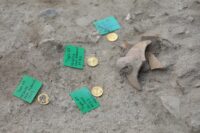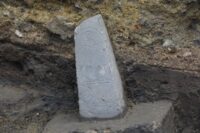 A group of five rare gold coins from the 3rd century B.C. have been discovered during excavation at the Tophet cemetery and temple in the suburbs of Carthage in Tunisia. Archaeologists from the National Institute of Heritage in Tunisia also unearthed stone funerary markers and urns containing the remains of infants and animals, some combined in the same vessel.
A group of five rare gold coins from the 3rd century B.C. have been discovered during excavation at the Tophet cemetery and temple in the suburbs of Carthage in Tunisia. Archaeologists from the National Institute of Heritage in Tunisia also unearthed stone funerary markers and urns containing the remains of infants and animals, some combined in the same vessel.
 The gold coins are just under an inch in diameter and bear the image of the goddess Tanit, the Punic mother goddess who, along with her consort Baal Hammon, were the chief deities of Carthage. The gold Tanit coins are rare on the archaeological record and were uncommon even in the 3rd century B.C. They were likely left at the tophet as offerings to the two deities by wealthy worshipers.
The gold coins are just under an inch in diameter and bear the image of the goddess Tanit, the Punic mother goddess who, along with her consort Baal Hammon, were the chief deities of Carthage. The gold Tanit coins are rare on the archaeological record and were uncommon even in the 3rd century B.C. They were likely left at the tophet as offerings to the two deities by wealthy worshipers.
 The urns are also votive offerings. The Tophet of Carthage, first explored by archaeologists in 1921, contains an astonishing 20,000 urns buried between 400 B.C. and 200 B.C. containing the cremated remains of animals (mainly lambs) and human children — fetuses, premature stillbirths, neonates, toddlers and a few up to four years old. Sometimes the remains of human infants were buried with the remains of lambs (and very occasionally other animals, like cows, pigs and birds). The soil of the tophet is thick with olive wood charcoal believed to be the remnants of sacrificial pyres.
The urns are also votive offerings. The Tophet of Carthage, first explored by archaeologists in 1921, contains an astonishing 20,000 urns buried between 400 B.C. and 200 B.C. containing the cremated remains of animals (mainly lambs) and human children — fetuses, premature stillbirths, neonates, toddlers and a few up to four years old. Sometimes the remains of human infants were buried with the remains of lambs (and very occasionally other animals, like cows, pigs and birds). The soil of the tophet is thick with olive wood charcoal believed to be the remnants of sacrificial pyres.
 Scholars have long debated whether this enormous quantity of cinerary remains of infants was evidence of Carthaginian child sacrifice or if was a necropolis dedicated to the burial of babies. There are no written Carthaginian sources to explain the burials, but Greek and Roman sources do claim that the practice of child sacrifice existed in Carthage. Greco-Roman sources are not considered reliable because they were at war with Carthage for so long and could have been spreading false information for propaganda purposes. Inscriptions on stone markers are ambiguous, but do seem to imply that the lambs were “substitutes,” ie, what people who were able to would offer to the gods in place of their own children. Recent archaeological explorations have concluded that the remains in the urns were indeed sacrifices, be they lamb or human child.
Scholars have long debated whether this enormous quantity of cinerary remains of infants was evidence of Carthaginian child sacrifice or if was a necropolis dedicated to the burial of babies. There are no written Carthaginian sources to explain the burials, but Greek and Roman sources do claim that the practice of child sacrifice existed in Carthage. Greco-Roman sources are not considered reliable because they were at war with Carthage for so long and could have been spreading false information for propaganda purposes. Inscriptions on stone markers are ambiguous, but do seem to imply that the lambs were “substitutes,” ie, what people who were able to would offer to the gods in place of their own children. Recent archaeological explorations have concluded that the remains in the urns were indeed sacrifices, be they lamb or human child.
Although once contested, experts have found “‘overwhelming’ evidence that … Carthaginian parents ritually sacrificed young children as an offering to the gods,” Oxford University said in a 2014 news release.
“Perhaps it was out of profound religious piety, or a sense that the good the sacrifice could bring the family or community as a whole outweighed the life of the child,” Josephine Quinn, the co-author of a study on the topic, told Oxford University.
“We have to remember the high level of mortality among children — it would have been sensible for parents not to get too attached to a child that might well not make its first birthday,” Quinn said. “We should not imagine that ancient people thought like us and were horrified by the same things.”